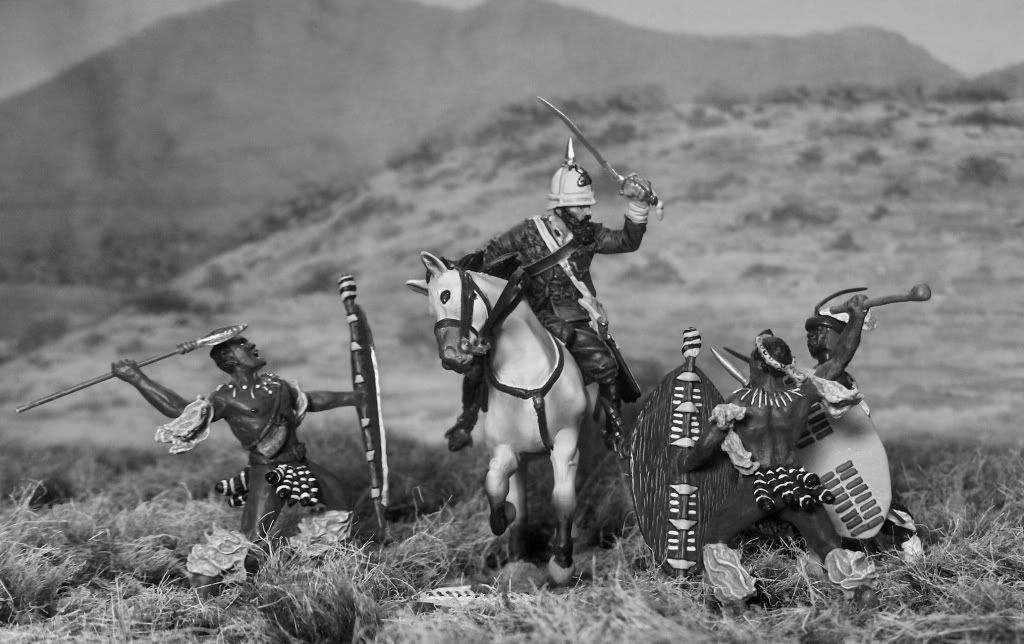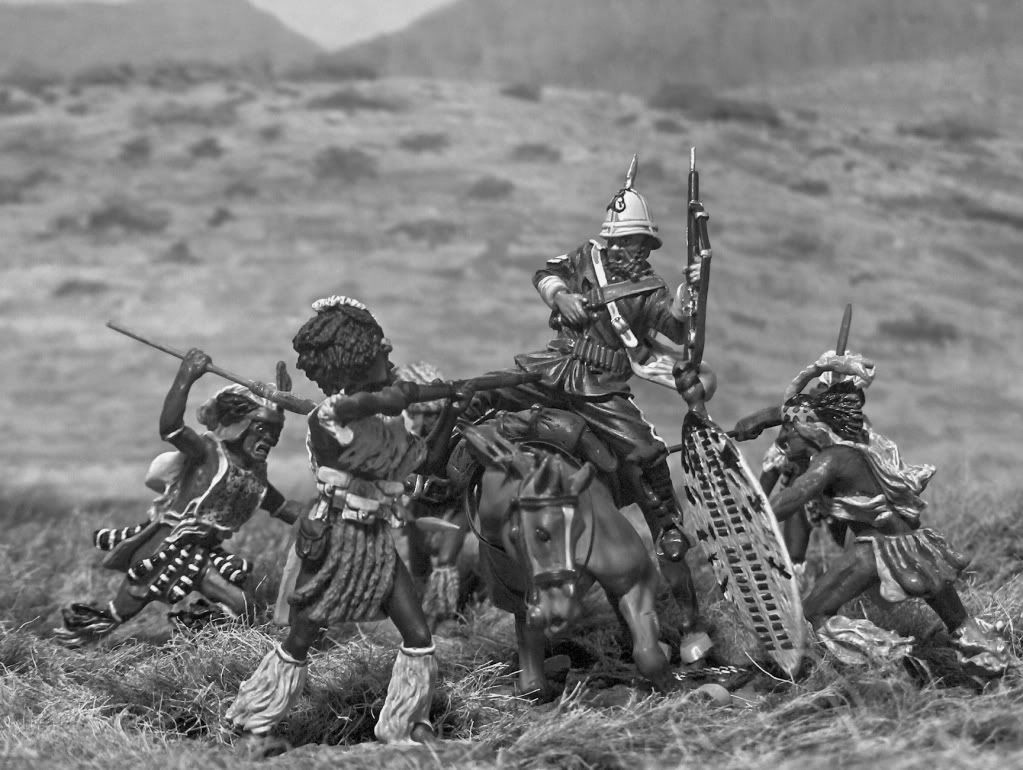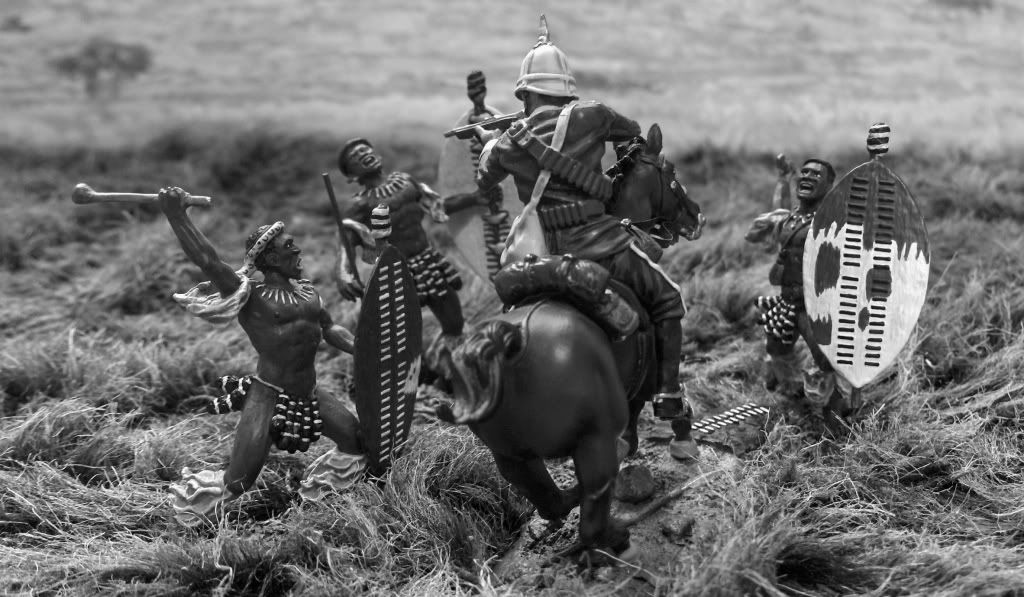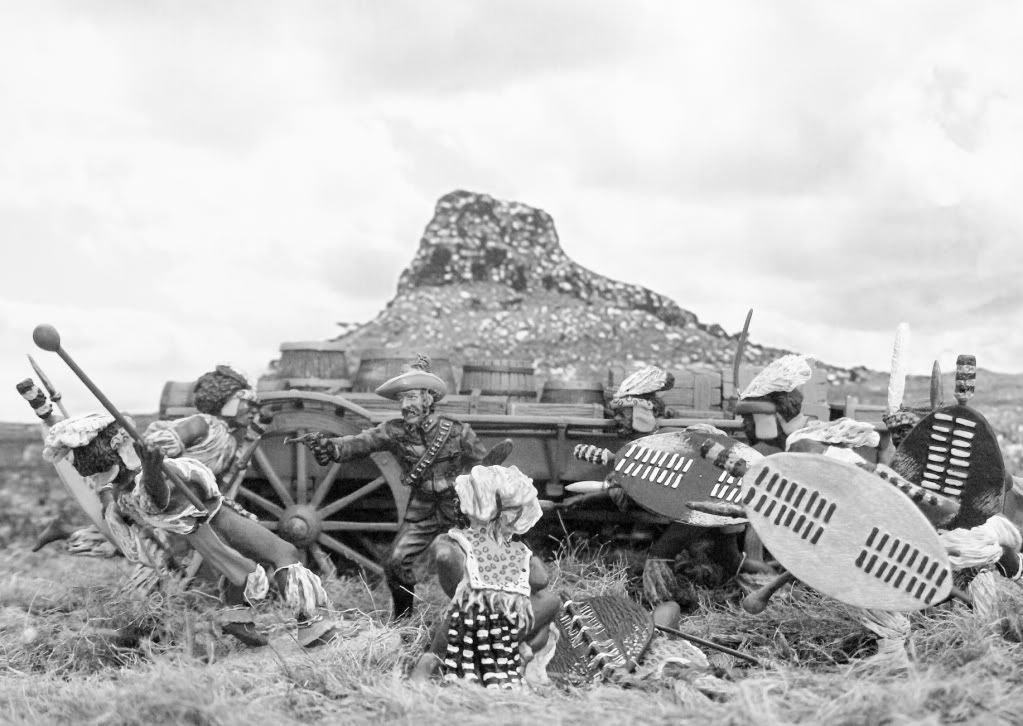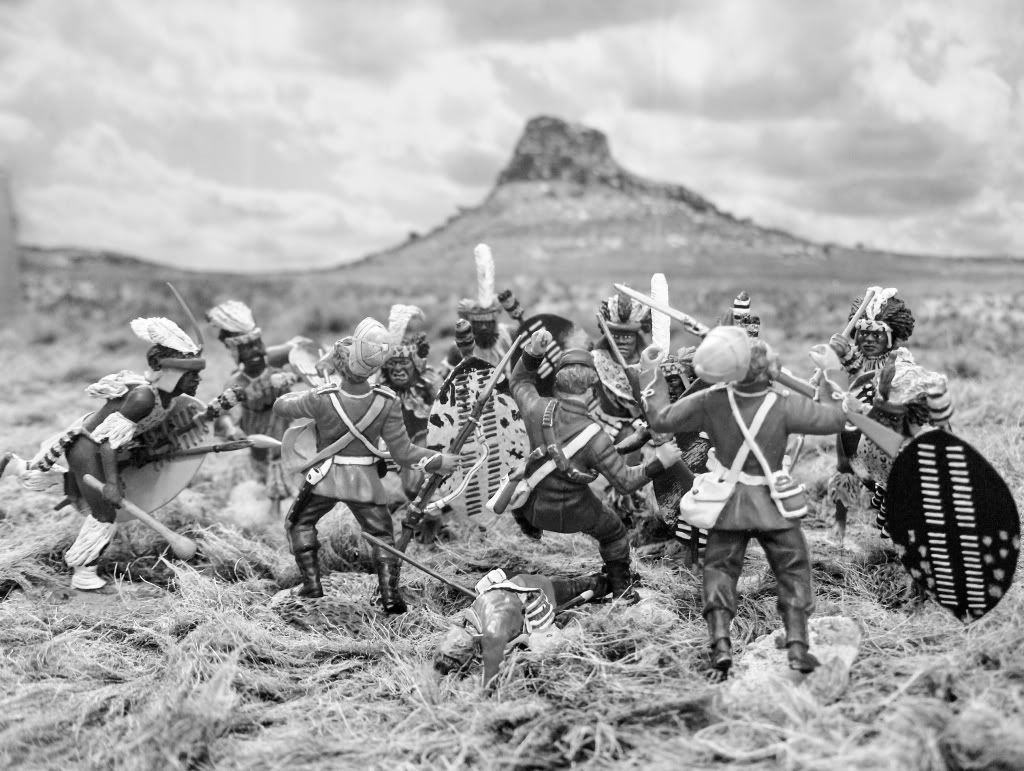You are using an out of date browser. It may not display this or other websites correctly.
You should upgrade or use an alternative browser.
You should upgrade or use an alternative browser.
"The Zulu War" (4 Viewers)
- Thread starter The Lt.
- Start date
The Lt.
Memoriam Member
- Joined
- Dec 10, 2006
- Messages
- 9,076
Thanks Kevin and Chris as it continues....
Hamilton –Browne, who was present at Gingindlovu, recorded “When I reached the Gatling the Zulu skirmishers were beginning to close in and the cool, staid old shell-back in charge of the gun was simply pop-popping at them in a quiet leisurely sort of a way, a proceeding that did not seem to meet with the approbation of a youthful ordinary seaman who was assisting him, and who, as I came up, said in rather an excited manner, " Fire quicker, Quarter-master, for Gawd's sake, fire quicker.” “Fire quicker," growled the ancient mariner, pausing to expectorate a much-chewed quid. "Fire quicker, yer young scupperling, fire quicker be d____d, wait till the black _______ come thicker," and for a few moments he continued his deliberate manipulations. Presently came the rush, … and the ordinary seaman had no longer need to exhort his senior to expedite the juice distributor which, fortunately not jamming and being backed up by the steady fire of the blue-jackets and jollies, in my humble opinion, saved the whole outfit from being cut up both physically and morally.”
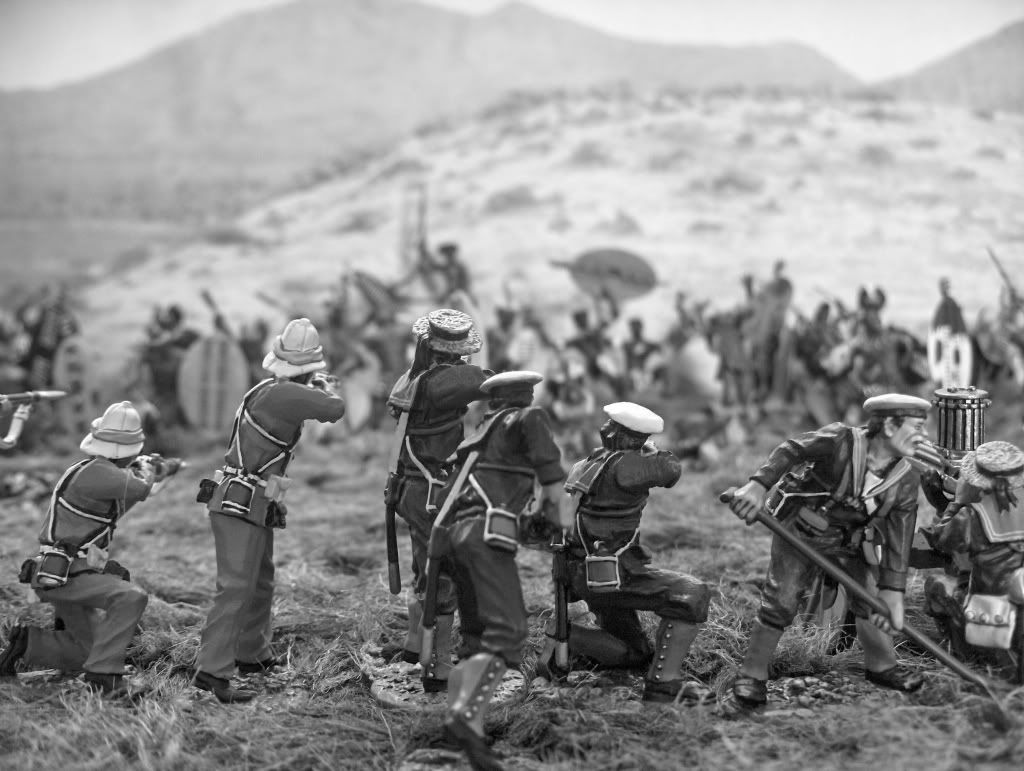
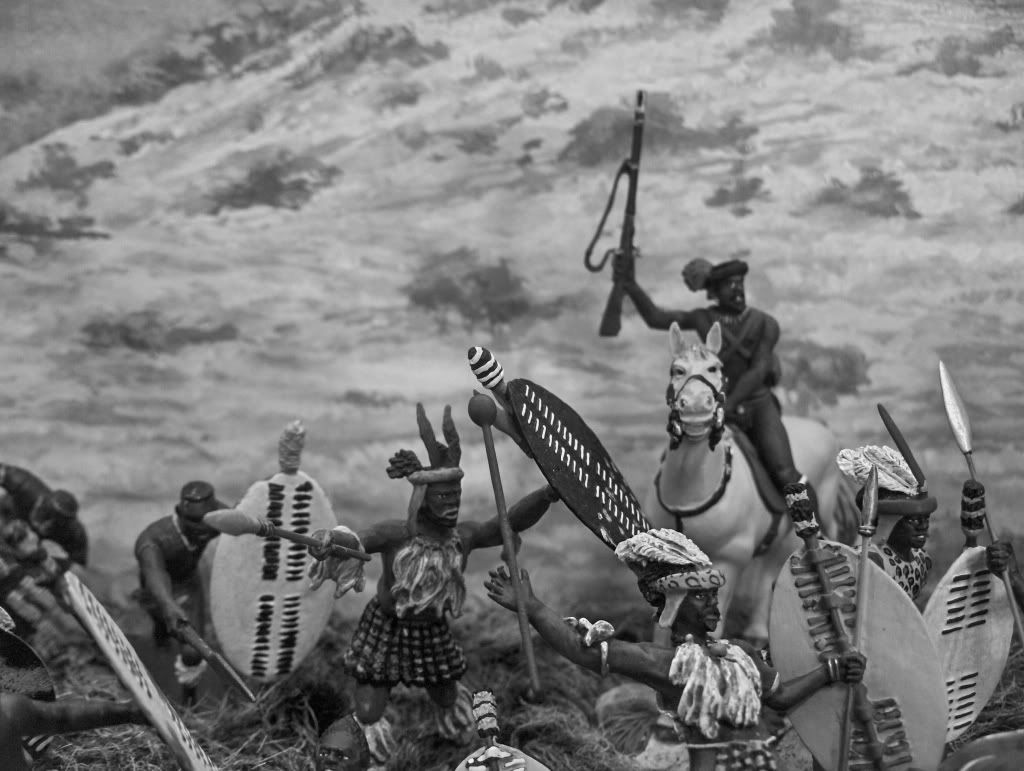
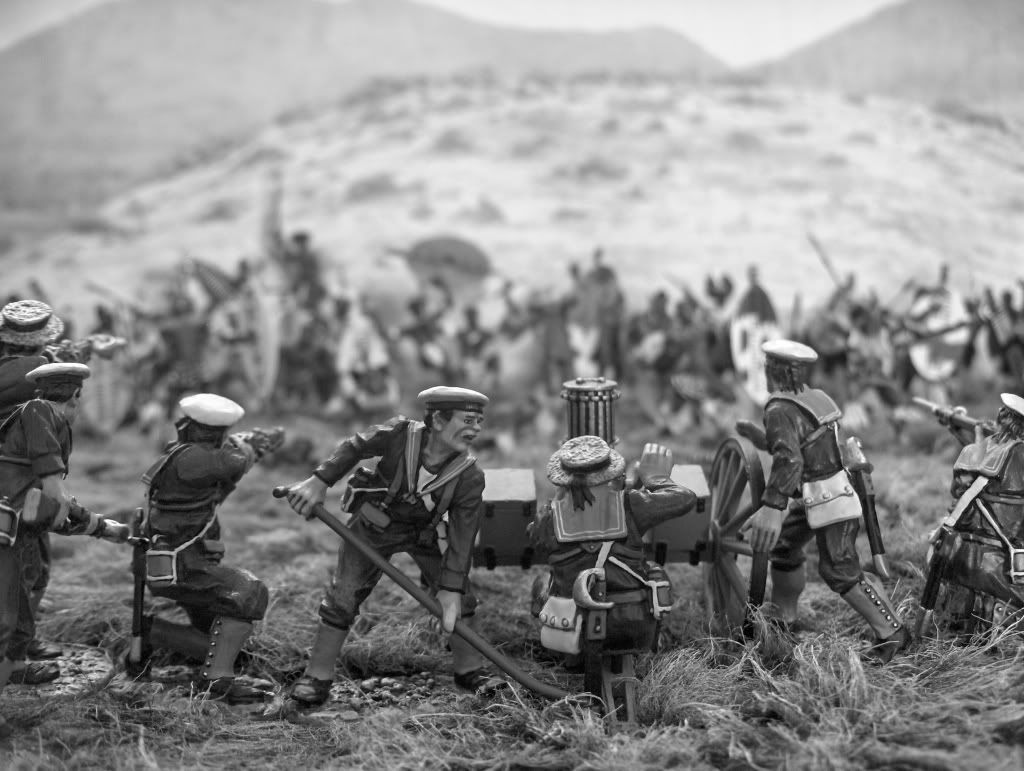
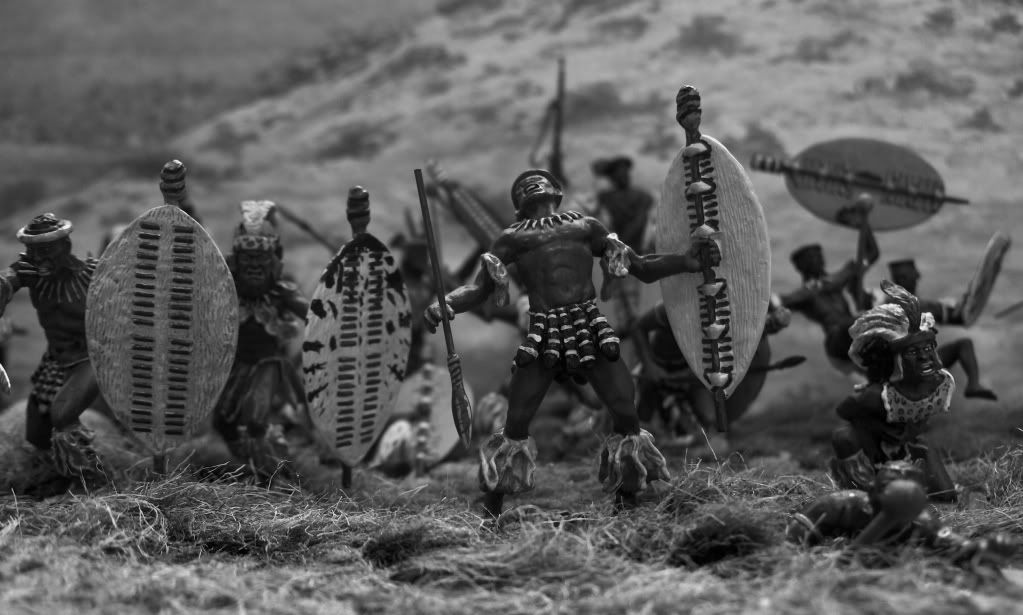
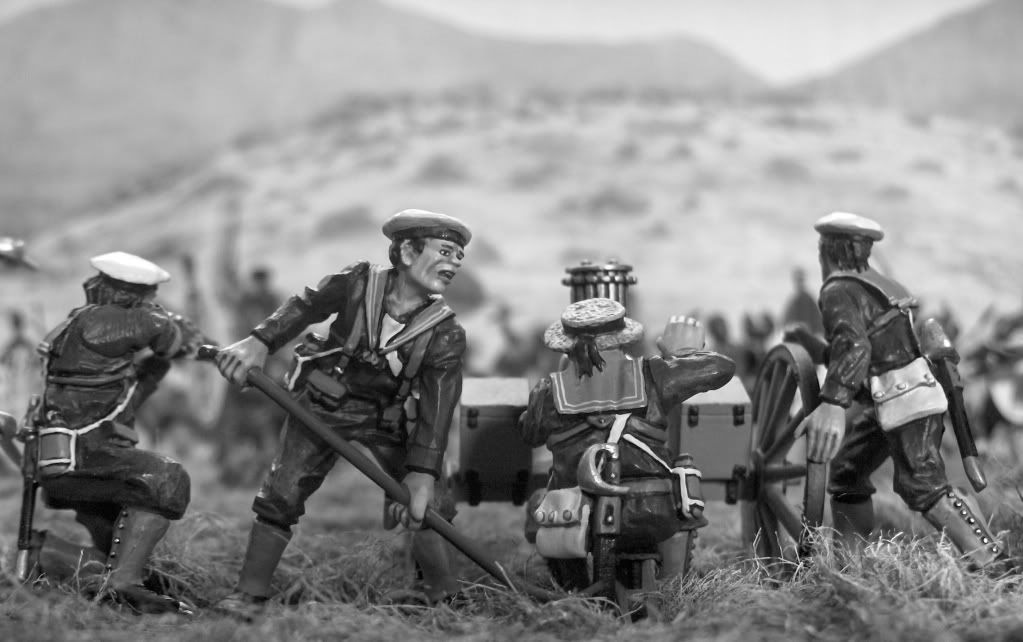
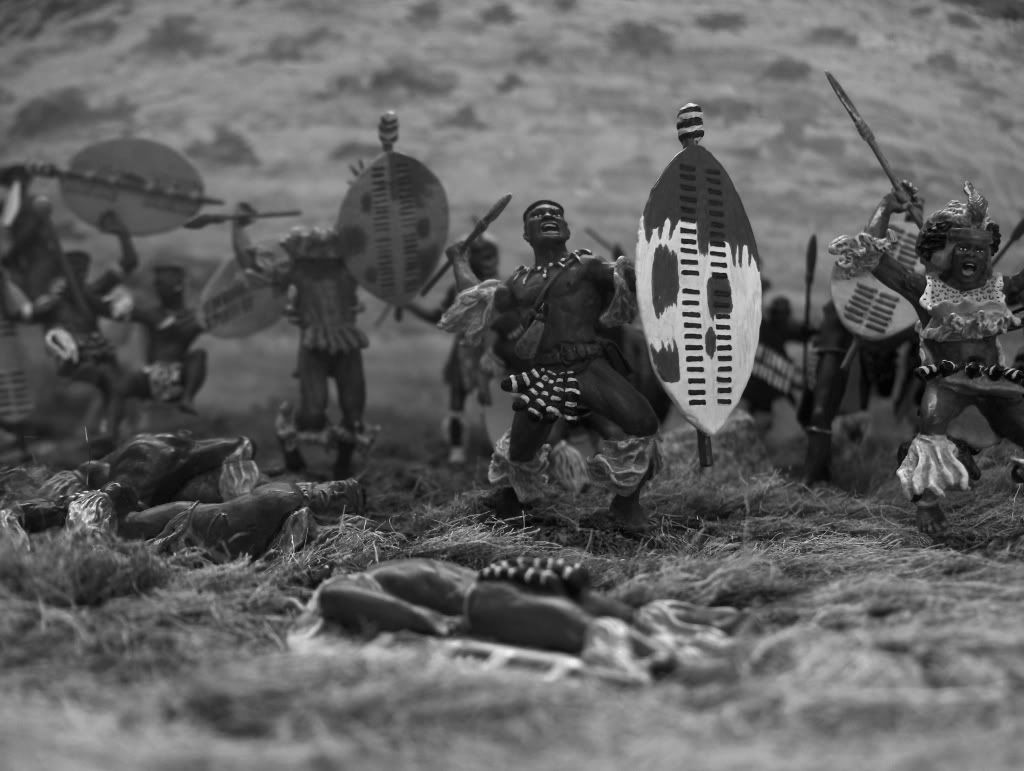

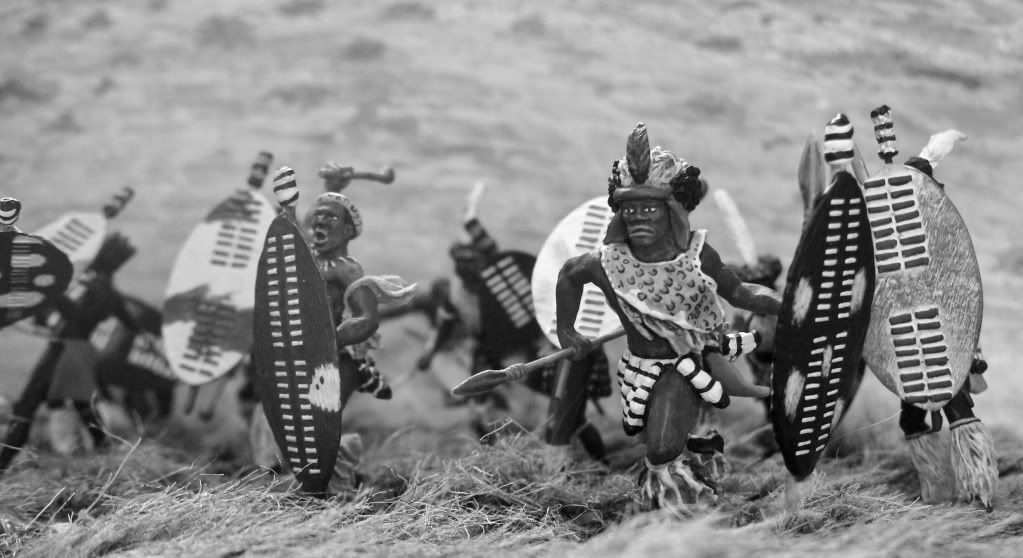
[
Hamilton –Browne, who was present at Gingindlovu, recorded “When I reached the Gatling the Zulu skirmishers were beginning to close in and the cool, staid old shell-back in charge of the gun was simply pop-popping at them in a quiet leisurely sort of a way, a proceeding that did not seem to meet with the approbation of a youthful ordinary seaman who was assisting him, and who, as I came up, said in rather an excited manner, " Fire quicker, Quarter-master, for Gawd's sake, fire quicker.” “Fire quicker," growled the ancient mariner, pausing to expectorate a much-chewed quid. "Fire quicker, yer young scupperling, fire quicker be d____d, wait till the black _______ come thicker," and for a few moments he continued his deliberate manipulations. Presently came the rush, … and the ordinary seaman had no longer need to exhort his senior to expedite the juice distributor which, fortunately not jamming and being backed up by the steady fire of the blue-jackets and jollies, in my humble opinion, saved the whole outfit from being cut up both physically and morally.”








[
GICOP
Four Star General
- Joined
- Oct 16, 2008
- Messages
- 28,310
Thanks Martyn as the battle rages on as pairs of defenders select and fire at their zulu warrior targets.
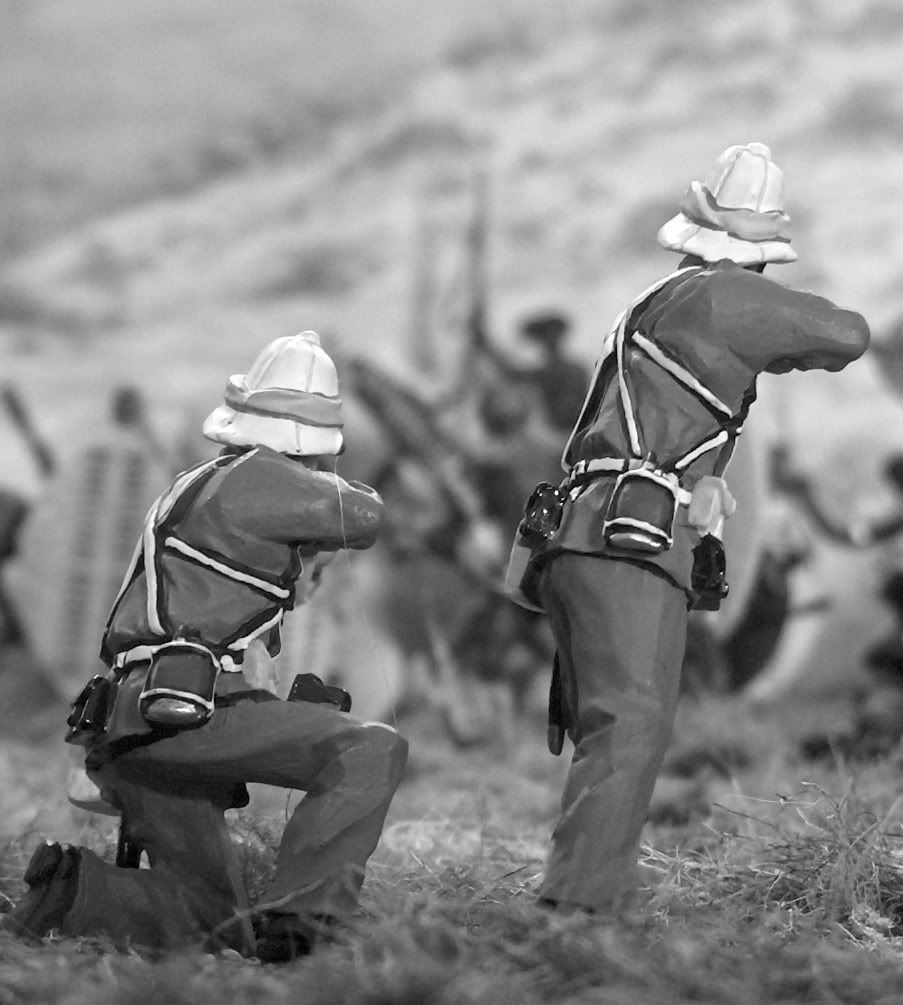

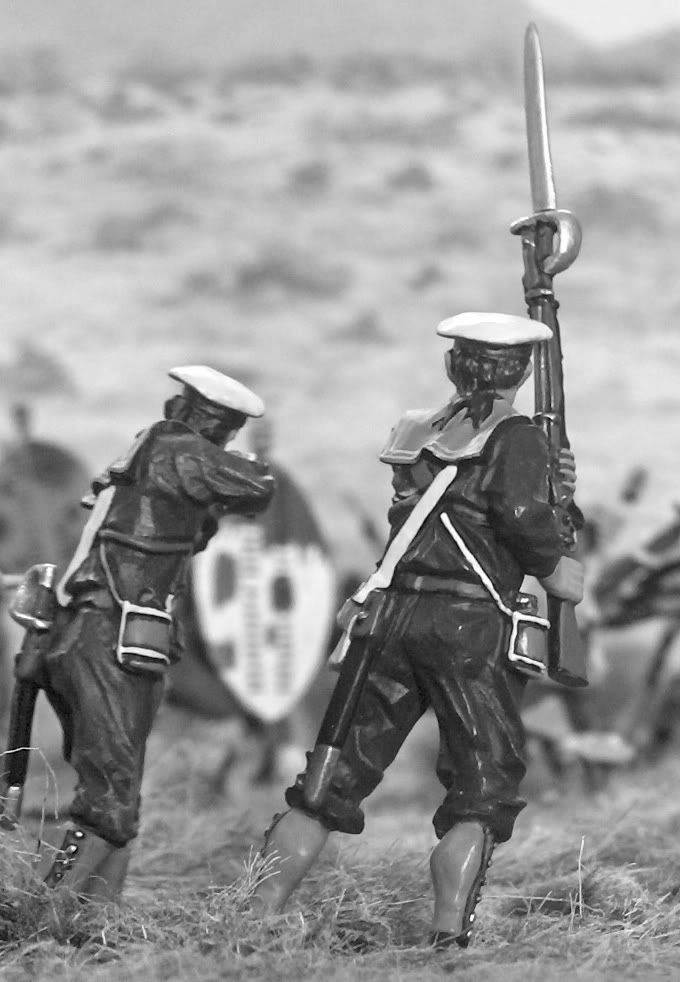
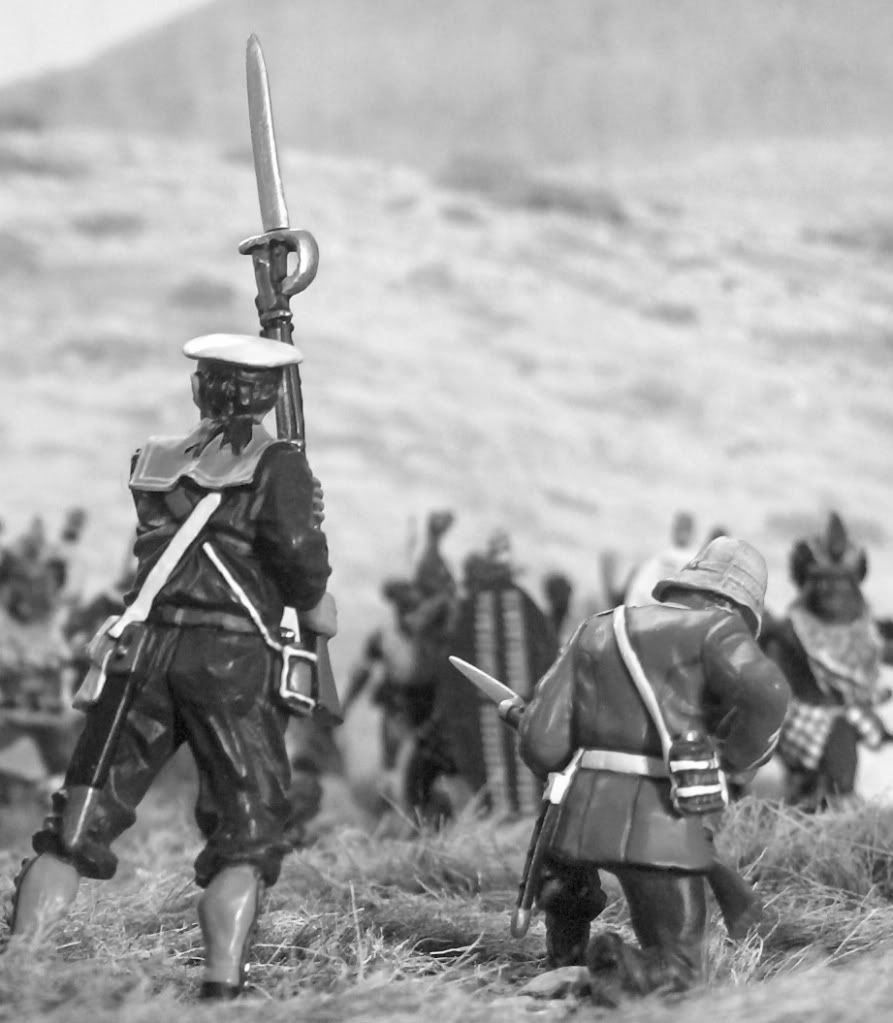
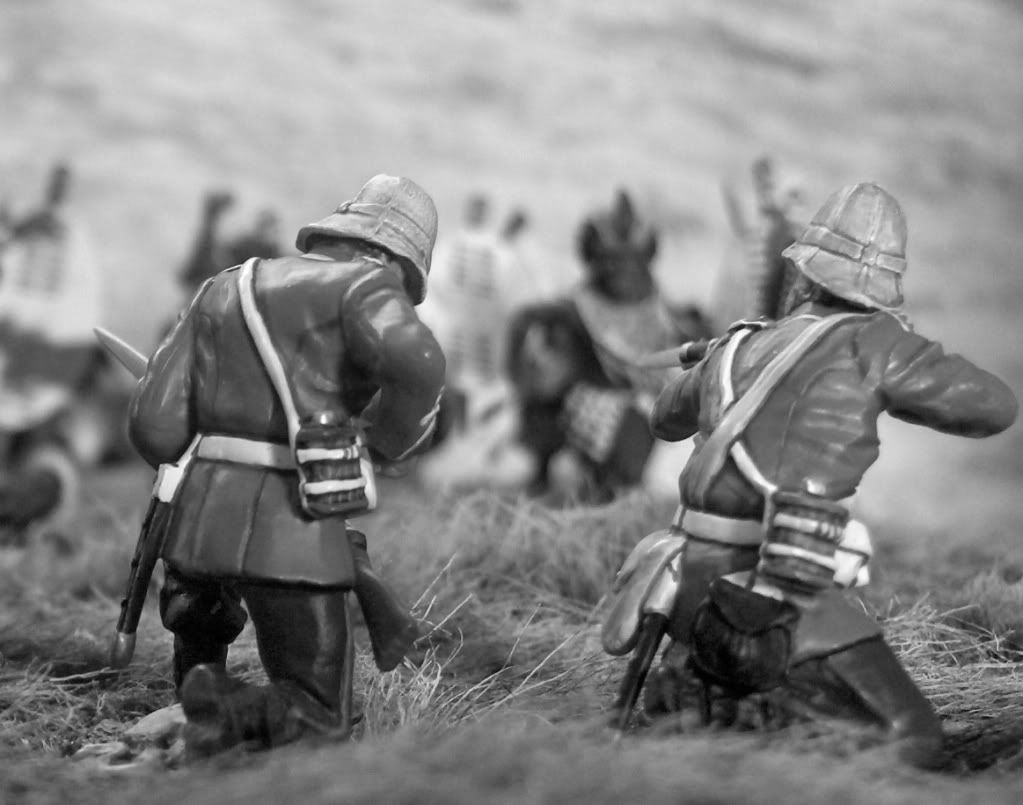
Great closeup pictures Joe :salute::
Cheers mate
Martyn
The Lt.
Memoriam Member
- Joined
- Dec 10, 2006
- Messages
- 9,076
The event of the fire power that brought the battle to an end brings this chaper of the Zulu War to and end.....The Lt.
Around the laager itself, 700 Zulu bodies were counted and 300 more were killed in the mounted chase of the retreating warriors. The British took eleven dead, including a Lieutenant-Colonel, and 48 wounded.
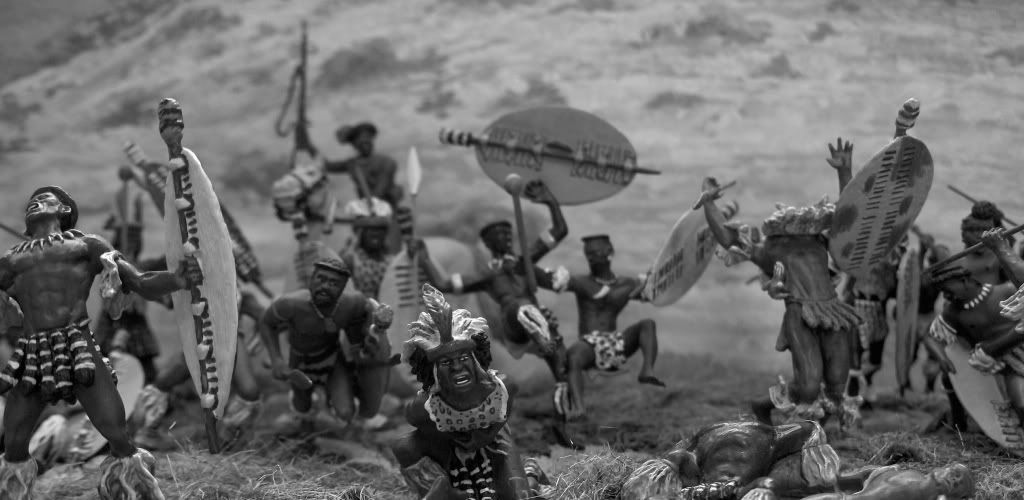
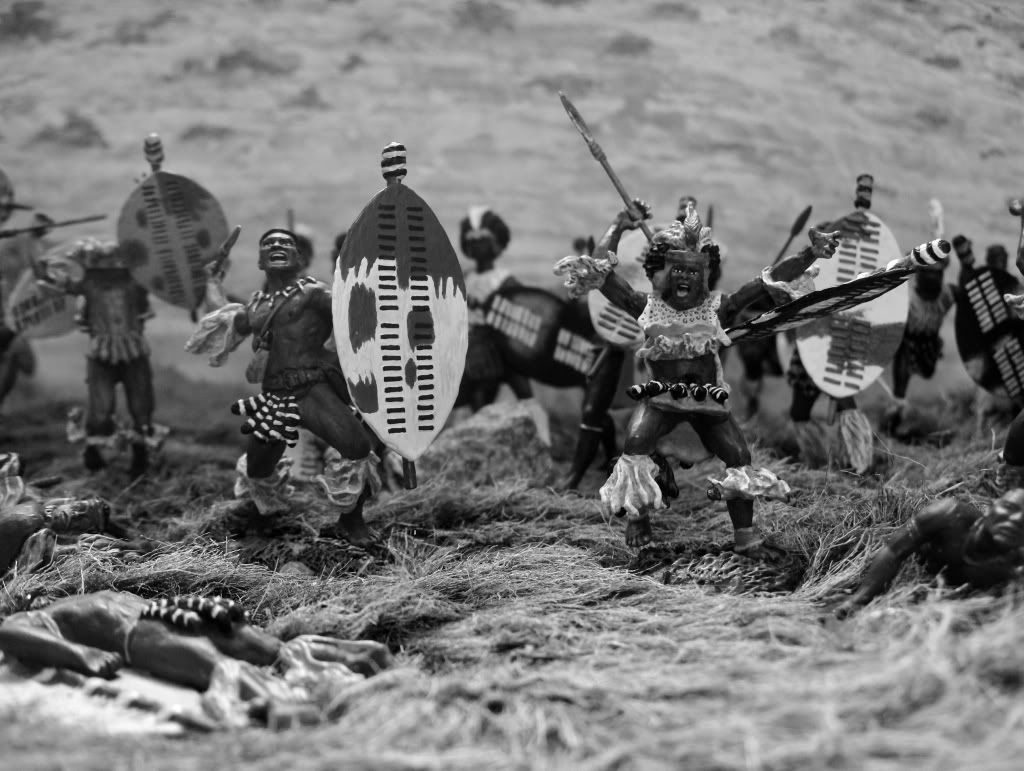


Around the laager itself, 700 Zulu bodies were counted and 300 more were killed in the mounted chase of the retreating warriors. The British took eleven dead, including a Lieutenant-Colonel, and 48 wounded.




GICOP
Four Star General
- Joined
- Oct 16, 2008
- Messages
- 28,310
The event of the fire power that brought the battle to an end brings this chaper of the Zulu War to and end.....The Lt.
Around the laager itself, 700 Zulu bodies were counted and 300 more were killed in the mounted chase of the retreating warriors. The British took eleven dead, including a Lieutenant-Colonel, and 48 wounded.




Great picture story Joe, and the Lieutenant Colonel who was killed was Lieutenant Colonel Northey of the 60th Rifles
Cheers mate
Martyn
GICOP
Four Star General
- Joined
- Oct 16, 2008
- Messages
- 28,310
Thanks Martyn as you'll see the Carbineer is still riding the gauntlet as he continues his efforts to escape......The Lt.
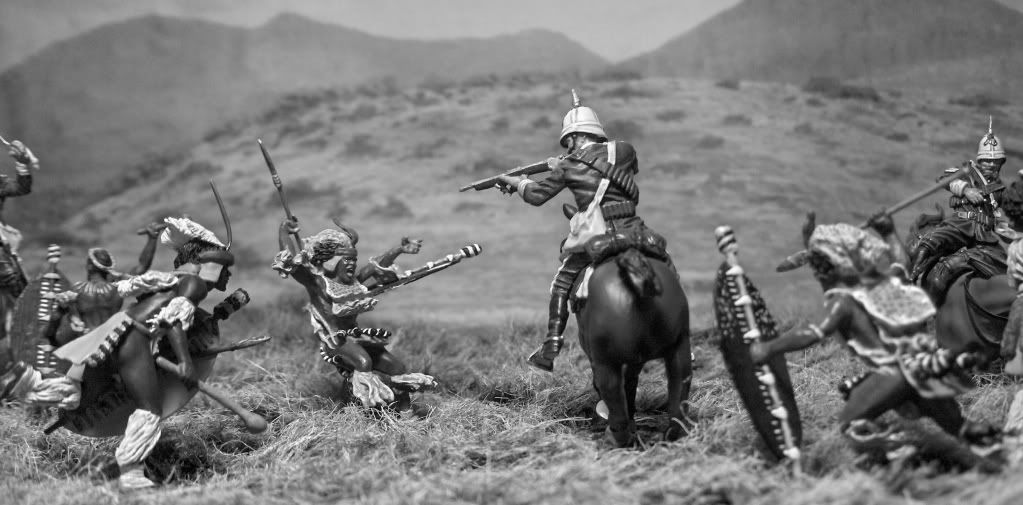
Bet he wished he had a repeating rifle Joe {eek3}
Great shot :salute::
Cheers mate
Martyn
The Lt.
Memoriam Member
- Joined
- Dec 10, 2006
- Messages
- 9,076
The Price Imperial Napoleon Eugene
At the outbreak of the Franco-Prussian War of 1870-1871, he accompanied his father to the front and first came under fire at Saarbrücken. When the war began to go against the Imperial arms, however, he had to flee from France with the Imperial Family and settled in England at Chislehurst, Kent. On his father's death, Bonapartists proclaimed him Napoleon IV. During the 1870s, there was some talk of a marriage between him and Queen Victoria's youngest daughter, Princess Beatrice. Toward the end of his life there were rumors, not all untrue, [that he was romantically attached to Spanish infanta María del Pilar, daughter of Queen Isabella II of SpainInfanta Pilar died the same year as Napoléon Eugène.
With the demise of the Second French Empire, the Prince Imperial was exiled to the United Kingdom, where he applied and was accepted to the Royal Military Academy, Woolwich. After finishing 17th in his class, he was commissioned into the Royal Artillery in order to follow in the footsteps of his famous great-uncle. Finally, with the outbreak of the Zulu War in 1879, the Prince Imperial, with the rank of lieutenant, forced the hand of the British military to allow him to take part in the conflict. He was only allowed to go to Africa by special pleading of his mother, the Empress Eugenie, and by Queen Victoria herself. He went as an observer, attached to the staff of Frederic Thesiger, 2nd Baron Chelmsford, the commander in South Africa, who was admonished to take care of him. Louis accompanied Chelmsford on his march into Zululand. Keen to see action, and full of enthusiasm, he was warned by Lieutenant Arthur Brigge, a close friend, "...to avoid running unnecessary risks. I reminded him of the Empress at home and his political party in France."
Chelmsford, mindful of his duty, attached the Prince to staff of Colonel Richard Harrison of the Royal Engineers, where it was felt he could be active but safe. Harrison was responsible for the column's transport and for reconnaissance of the forward route on the way to Ulundi, the Zulu capital. While he welcomed the presence of Louis, he was told by Chelmsford that the Prince must be accompanied at all times by a strong escort. Lieutenant Jahleel Brenton Carey, a French speaker and British subject from Guernsey, was given particular charge of Louis. The Prince took part in several reconnaissance missions, though his eagerness for action almost led him into an early ambush, when he exceeded orders in a party led by Colonel Redvers Buller. Despite this on the evening of 31 May 1879. Harrison agreed to allow Louis to scout in a forward party scheduled to leave in the morning, in the mistaken belief that the path ahead was free of Zulu skirmishers. (It was a constant feature of the whole campaign for the British to underestimate the capacity of the Zulus, particularly the skill of their light infantry in ambush).
On the morning of 1 June the troop set out, earlier than intended, and without the full escort, largely owing to Louis' impatience. Led by Carey, the scouts rode deeper into Zululand. Without Harrison or Buller present to restrain him, the Prince took command from Carey, even though the latter had seniority. At noon the troop was halted at a temporarily deserted kraal while Louis and Carey made some sketches of the terrain, and used part of the thatch to make a fire. No lookout was posted. As they were preparing to leave, about 40 Zulus fired upon them and rushed screaming uSuthu! ("kill") towards them. The Prince's horse dashed off before he could mount, the Prince clinging to a holster on the saddle - after about a hundred yards a strap broke, and the Prince fell beneath his horse, trampling his right arm. He leapt up, drawing his revolver with his left hand, and started to run - but the Zulus could run faster.
The Prince was speared in the thigh, pulled the assegai from his wound, and turned and fired on his pursuers; another assegai struck his left shoulder. The Prince tried to fight on, using the assegai he had pulled from his leg, but weakened by his wounds, he sank to the ground and was overwhelmed. When recovered his body had 18 assegai wounds. Two of his escort had been killed, and another was missing. Lt. Carey and the remaining four came together about 50 yards from where the Prince made his final stand - but not a single shot did they fire at the Zulus. Carey led his men back to camp, where he was greeted warmly for the last time in his career - after a court of inquiry, a court martial, intervention by the Empress Eugenie and Queen Victoria, he was to return to his regiment a pariah - shunned by his fellow officers for not standing and fighting. He endured six years of social hell before his death in Bombay.
Wolseley stated as "a plucky young man, and he died a soldier's death. What on earth could he have done better?”
After death the Prince was ritually disemboweled by one Hlabanatunga, a common Zulu practice to prevent his spirit seeking revenge on his killers in the afterlife. His badly decomposed body was brought back to England and buried in Chislehurst. Later, it was transferred to a special mausoleum constructed by his mother as the Imperial Crypt at Saint Michael's Abbey, Farnborough, Hampshire, England, next to his father.
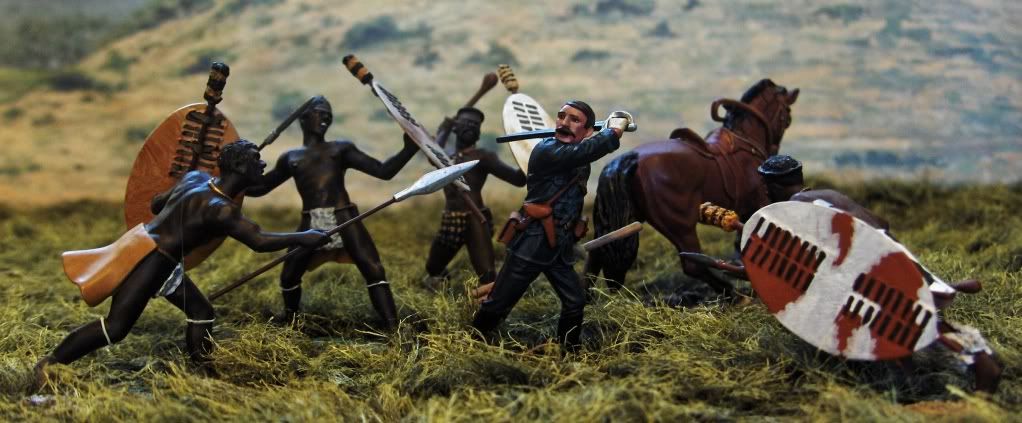
At the outbreak of the Franco-Prussian War of 1870-1871, he accompanied his father to the front and first came under fire at Saarbrücken. When the war began to go against the Imperial arms, however, he had to flee from France with the Imperial Family and settled in England at Chislehurst, Kent. On his father's death, Bonapartists proclaimed him Napoleon IV. During the 1870s, there was some talk of a marriage between him and Queen Victoria's youngest daughter, Princess Beatrice. Toward the end of his life there were rumors, not all untrue, [that he was romantically attached to Spanish infanta María del Pilar, daughter of Queen Isabella II of SpainInfanta Pilar died the same year as Napoléon Eugène.
With the demise of the Second French Empire, the Prince Imperial was exiled to the United Kingdom, where he applied and was accepted to the Royal Military Academy, Woolwich. After finishing 17th in his class, he was commissioned into the Royal Artillery in order to follow in the footsteps of his famous great-uncle. Finally, with the outbreak of the Zulu War in 1879, the Prince Imperial, with the rank of lieutenant, forced the hand of the British military to allow him to take part in the conflict. He was only allowed to go to Africa by special pleading of his mother, the Empress Eugenie, and by Queen Victoria herself. He went as an observer, attached to the staff of Frederic Thesiger, 2nd Baron Chelmsford, the commander in South Africa, who was admonished to take care of him. Louis accompanied Chelmsford on his march into Zululand. Keen to see action, and full of enthusiasm, he was warned by Lieutenant Arthur Brigge, a close friend, "...to avoid running unnecessary risks. I reminded him of the Empress at home and his political party in France."
Chelmsford, mindful of his duty, attached the Prince to staff of Colonel Richard Harrison of the Royal Engineers, where it was felt he could be active but safe. Harrison was responsible for the column's transport and for reconnaissance of the forward route on the way to Ulundi, the Zulu capital. While he welcomed the presence of Louis, he was told by Chelmsford that the Prince must be accompanied at all times by a strong escort. Lieutenant Jahleel Brenton Carey, a French speaker and British subject from Guernsey, was given particular charge of Louis. The Prince took part in several reconnaissance missions, though his eagerness for action almost led him into an early ambush, when he exceeded orders in a party led by Colonel Redvers Buller. Despite this on the evening of 31 May 1879. Harrison agreed to allow Louis to scout in a forward party scheduled to leave in the morning, in the mistaken belief that the path ahead was free of Zulu skirmishers. (It was a constant feature of the whole campaign for the British to underestimate the capacity of the Zulus, particularly the skill of their light infantry in ambush).
On the morning of 1 June the troop set out, earlier than intended, and without the full escort, largely owing to Louis' impatience. Led by Carey, the scouts rode deeper into Zululand. Without Harrison or Buller present to restrain him, the Prince took command from Carey, even though the latter had seniority. At noon the troop was halted at a temporarily deserted kraal while Louis and Carey made some sketches of the terrain, and used part of the thatch to make a fire. No lookout was posted. As they were preparing to leave, about 40 Zulus fired upon them and rushed screaming uSuthu! ("kill") towards them. The Prince's horse dashed off before he could mount, the Prince clinging to a holster on the saddle - after about a hundred yards a strap broke, and the Prince fell beneath his horse, trampling his right arm. He leapt up, drawing his revolver with his left hand, and started to run - but the Zulus could run faster.
The Prince was speared in the thigh, pulled the assegai from his wound, and turned and fired on his pursuers; another assegai struck his left shoulder. The Prince tried to fight on, using the assegai he had pulled from his leg, but weakened by his wounds, he sank to the ground and was overwhelmed. When recovered his body had 18 assegai wounds. Two of his escort had been killed, and another was missing. Lt. Carey and the remaining four came together about 50 yards from where the Prince made his final stand - but not a single shot did they fire at the Zulus. Carey led his men back to camp, where he was greeted warmly for the last time in his career - after a court of inquiry, a court martial, intervention by the Empress Eugenie and Queen Victoria, he was to return to his regiment a pariah - shunned by his fellow officers for not standing and fighting. He endured six years of social hell before his death in Bombay.
Wolseley stated as "a plucky young man, and he died a soldier's death. What on earth could he have done better?”
After death the Prince was ritually disemboweled by one Hlabanatunga, a common Zulu practice to prevent his spirit seeking revenge on his killers in the afterlife. His badly decomposed body was brought back to England and buried in Chislehurst. Later, it was transferred to a special mausoleum constructed by his mother as the Imperial Crypt at Saint Michael's Abbey, Farnborough, Hampshire, England, next to his father.

GICOP
Four Star General
- Joined
- Oct 16, 2008
- Messages
- 28,310
The Price Imperial Napoleon Eugene
At the outbreak of the Franco-Prussian War of 1870-1871, he accompanied his father to the front and first came under fire at Saarbrücken. When the war began to go against the Imperial arms, however, he had to flee from France with the Imperial Family and settled in England at Chislehurst, Kent. On his father's death, Bonapartists proclaimed him Napoleon IV. During the 1870s, there was some talk of a marriage between him and Queen Victoria's youngest daughter, Princess Beatrice. Toward the end of his life there were rumors, not all untrue, [that he was romantically attached to Spanish infanta María del Pilar, daughter of Queen Isabella II of SpainInfanta Pilar died the same year as Napoléon Eugène.
With the demise of the Second French Empire, the Prince Imperial was exiled to the United Kingdom, where he applied and was accepted to the Royal Military Academy, Woolwich. After finishing 17th in his class, he was commissioned into the Royal Artillery in order to follow in the footsteps of his famous great-uncle. Finally, with the outbreak of the Zulu War in 1879, the Prince Imperial, with the rank of lieutenant, forced the hand of the British military to allow him to take part in the conflict. He was only allowed to go to Africa by special pleading of his mother, the Empress Eugenie, and by Queen Victoria herself. He went as an observer, attached to the staff of Frederic Thesiger, 2nd Baron Chelmsford, the commander in South Africa, who was admonished to take care of him. Louis accompanied Chelmsford on his march into Zululand. Keen to see action, and full of enthusiasm, he was warned by Lieutenant Arthur Brigge, a close friend, "...to avoid running unnecessary risks. I reminded him of the Empress at home and his political party in France."
Chelmsford, mindful of his duty, attached the Prince to staff of Colonel Richard Harrison of the Royal Engineers, where it was felt he could be active but safe. Harrison was responsible for the column's transport and for reconnaissance of the forward route on the way to Ulundi, the Zulu capital. While he welcomed the presence of Louis, he was told by Chelmsford that the Prince must be accompanied at all times by a strong escort. Lieutenant Jahleel Brenton Carey, a French speaker and British subject from Guernsey, was given particular charge of Louis. The Prince took part in several reconnaissance missions, though his eagerness for action almost led him into an early ambush, when he exceeded orders in a party led by Colonel Redvers Buller. Despite this on the evening of 31 May 1879. Harrison agreed to allow Louis to scout in a forward party scheduled to leave in the morning, in the mistaken belief that the path ahead was free of Zulu skirmishers. (It was a constant feature of the whole campaign for the British to underestimate the capacity of the Zulus, particularly the skill of their light infantry in ambush).
On the morning of 1 June the troop set out, earlier than intended, and without the full escort, largely owing to Louis' impatience. Led by Carey, the scouts rode deeper into Zululand. Without Harrison or Buller present to restrain him, the Prince took command from Carey, even though the latter had seniority. At noon the troop was halted at a temporarily deserted kraal while Louis and Carey made some sketches of the terrain, and used part of the thatch to make a fire. No lookout was posted. As they were preparing to leave, about 40 Zulus fired upon them and rushed screaming uSuthu! ("kill") towards them. The Prince's horse dashed off before he could mount, the Prince clinging to a holster on the saddle - after about a hundred yards a strap broke, and the Prince fell beneath his horse, trampling his right arm. He leapt up, drawing his revolver with his left hand, and started to run - but the Zulus could run faster.
The Prince was speared in the thigh, pulled the assegai from his wound, and turned and fired on his pursuers; another assegai struck his left shoulder. The Prince tried to fight on, using the assegai he had pulled from his leg, but weakened by his wounds, he sank to the ground and was overwhelmed. When recovered his body had 18 assegai wounds. Two of his escort had been killed, and another was missing. Lt. Carey and the remaining four came together about 50 yards from where the Prince made his final stand - but not a single shot did they fire at the Zulus. Carey led his men back to camp, where he was greeted warmly for the last time in his career - after a court of inquiry, a court martial, intervention by the Empress Eugenie and Queen Victoria, he was to return to his regiment a pariah - shunned by his fellow officers for not standing and fighting. He endured six years of social hell before his death in Bombay.
Wolseley stated as "a plucky young man, and he died a soldier's death. What on earth could he have done better?”
After death the Prince was ritually disemboweled by one Hlabanatunga, a common Zulu practice to prevent his spirit seeking revenge on his killers in the afterlife. His badly decomposed body was brought back to England and buried in Chislehurst. Later, it was transferred to a special mausoleum constructed by his mother as the Imperial Crypt at Saint Michael's Abbey, Farnborough, Hampshire, England, next to his father.

I will have to get some of my Mounted Infantry to help the Prince Imperial, something that didin't happen on the day{eek3}
Cheers mate
Martyn
The Lt.
Memoriam Member
- Joined
- Dec 10, 2006
- Messages
- 9,076
I will have to get some of my Mounted Infantry to help the Prince Imperial, something that didin't happen on the day{eek3}
Cheers mate
Martyn
Will be looking forward to you doing so Martyn in the mean time here's another last stand by an officer of the 24th.
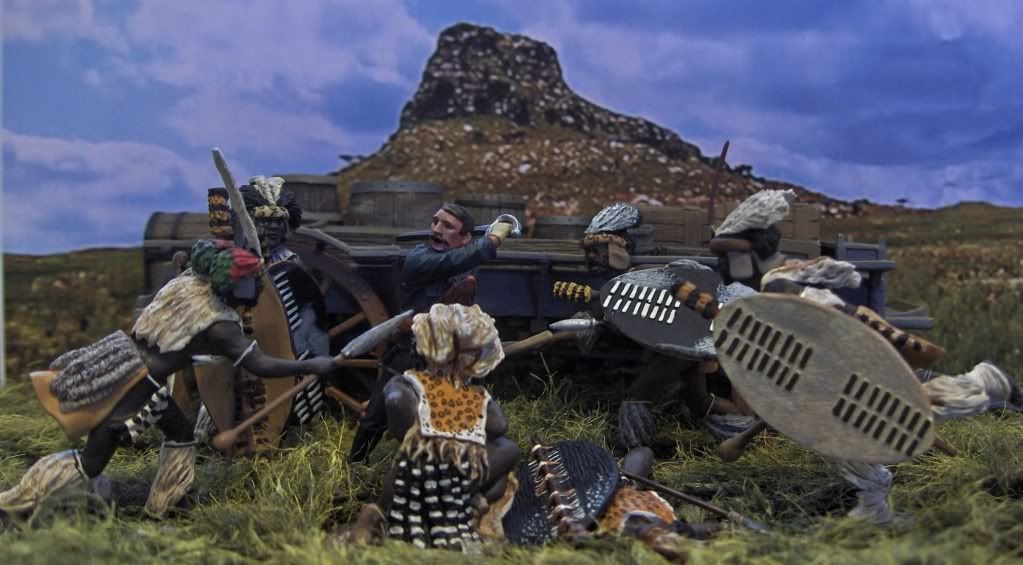
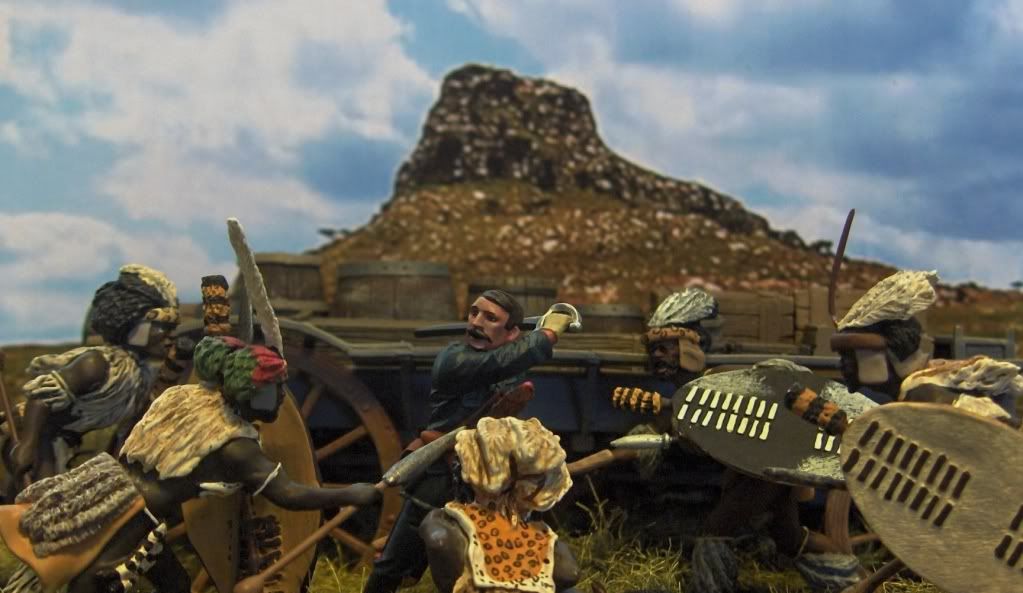
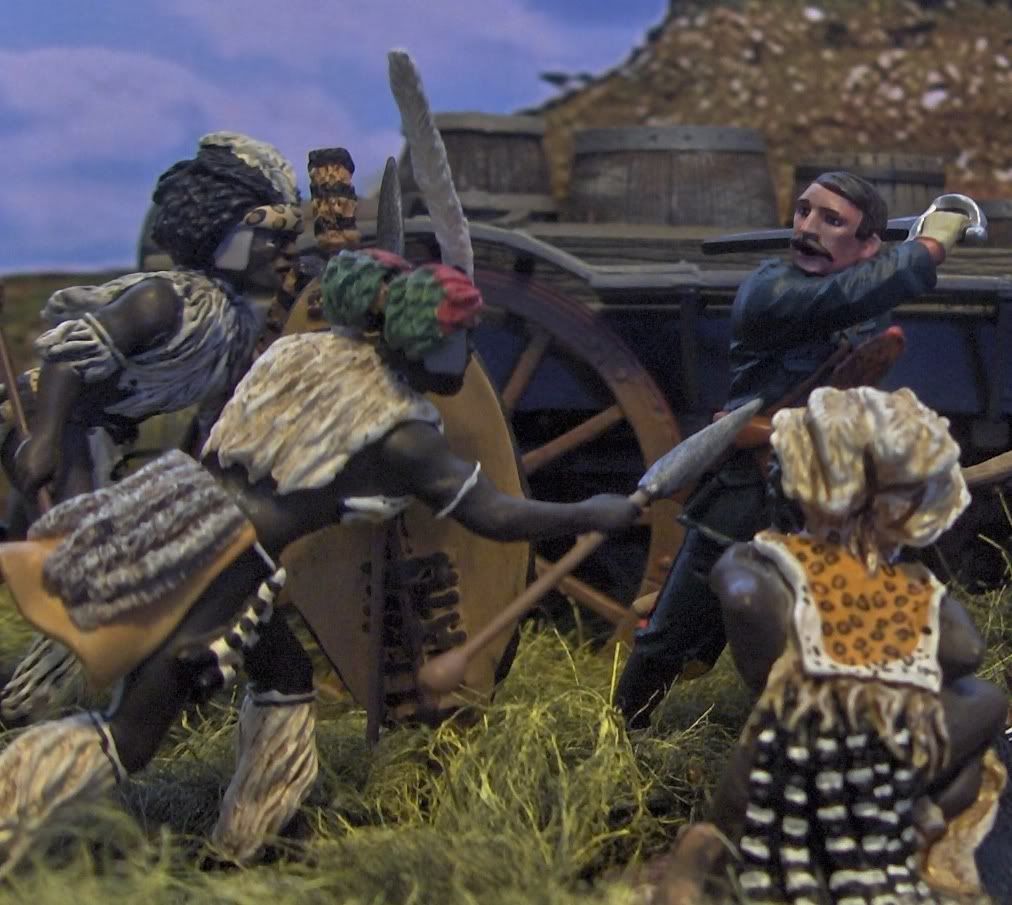
GICOP
Four Star General
- Joined
- Oct 16, 2008
- Messages
- 28,310
Will be looking forward to you doing so Martyn in the mean time here's another last stand by an officer of the 24th.



That is a great action dio Joe, nice start to my Friday {bravo}}{bravo}}{bravo}}
Cheers mate
Martyn
The Lt.
Memoriam Member
- Joined
- Dec 10, 2006
- Messages
- 9,076
Unlike the in the Movie Zulu Dawn where Colonel Durford played by Burt Lancaster is seen a top of a wagon defending himself the following scenes may cast some light on how he met his end along with to fellow British Officers..........The Lt.




GICOP
Four Star General
- Joined
- Oct 16, 2008
- Messages
- 28,310
Unlike the in the Movie Zulu Dawn where Colonel Durford played by Burt Lancaster is seen a top of a wagon defending himself the following scenes may cast some light on how he met his end along with to fellow British Officers..........The Lt.


More than likely Joe, great pictures {bravo}}
Cheers mate
Martyn
Users who are viewing this thread
Total: 5 (members: 0, guests: 5)


